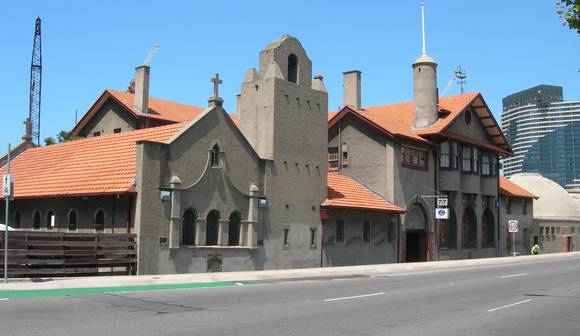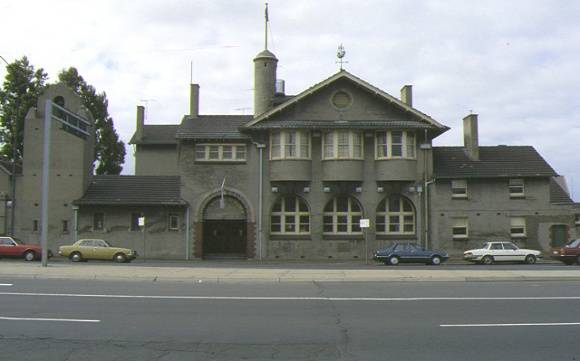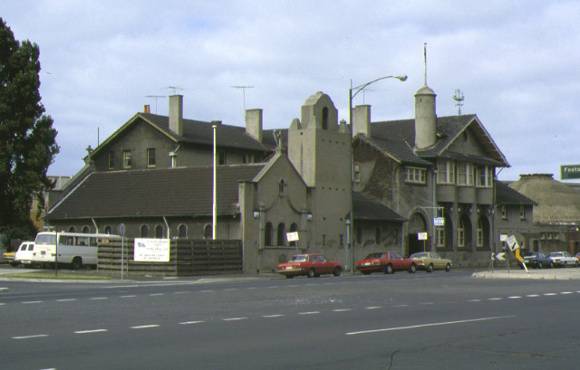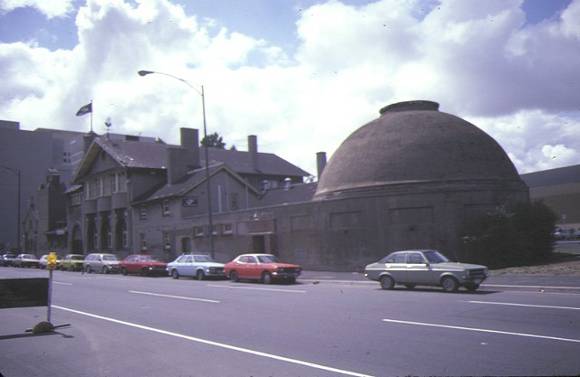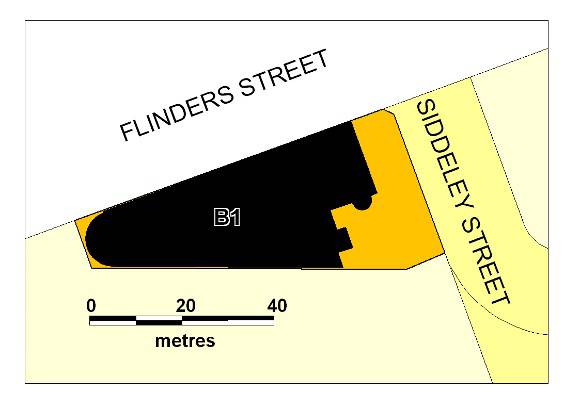| Back to search results » | Back to search page » |
|
MISSIONS TO SEAMEN
Other NameMISSION TO SEAFARERS Location717 FLINDERS STREET DOCKLANDS, MELBOURNE CITY
File Number603638LevelRegistered |
|
Statement of Significance
What is significant? During 1916 the architect Walter Richmond Butler designed a new
Anglican Mission to Seamen to replace premises in Siddeley Street,
which had been resumed by the Harbour Trust during wharf extensions.
The buildings, on reinforced concrete footings, are in rendered brick
with tiled roofs. Butler designed the complex using a mixture of
styles, one of which was the Spanish Mission Revival which had become
prevalent on the west coast of America, especially California and New
Mexico, during the 1890s. The style revived the architectural legacy
of Spanish colonialism of the eighteenth century and the associated
Franciscan missions. The revival of the style is explicit in the
chapel with its rough-hewn timber trusses, in the bell tower with its
pinnacles and turret surmounted by a rustic cross and in the
monastic-like courtyard. The adjoining administration, residential and
recreational building shows the influence of English domestic Arts and
Crafts architecture, with its projecting gable, pepper pot chimneys
and three adjoining oriel windows. Walter Butler, architect to the
Anglican Diocese in Melbourne, had come to Australia with an intimate
knowledge and experience of the Arts and Crafts movement and continued
to use the style in his residential designs of the 1920s. The main
hall has a reinforced concrete vaulted ceiling. Lady Stanley, wife of
the Mission's patron Governor Stanley, laid the foundation stone of
the complex in November 1916. The buildings were financed partly by a
compensation payment from the Harbour Trust of £8,500 and £3,000 from
local merchants and shipping firms. The Ladies' Harbour Lights Guild
raised over £800 for the chapel. Most of the complex was completed by
late 1917 whilst the Pantheon-like gymnasium with oculus was finished
soon afterwards. The substantially intact interiors, including
extensive use of wall panelling in Tasmanian hardwood, form an
integral part of the overall design. How is it significant? The Missions to Seamen buildings are of architectural, aesthetic and
historical significance to the State of Victoria. Why is it significant? The Missions to Seamen buildings are architecturally significant as a
milestone in the introduction of the Spanish Mission style to
Melbourne. The style was to later find widespread popularity in the
suburbs of Melbourne. The choice of Spanish Mission directly refers to
the Christian purpose of the complex. The Missions to Seamen buildings
are unusual for combining two distinct architectural styles, for they
also reflect the imitation of English domestic architecture, the Arts
and Crafts movement. Butler was one of the most prominent and
progressive architects of the period and the complex is one of his
most unusual and distinctive works. Notable interior features include
the chapel, the internal courtyard and loggia, the main hall and lobby
and the domed gymnasium with oculus. The chapel is of architectural
and aesthetic significance for its timber truss roof and its fine
collection of crafted joinery, including the altar and sanctuary
chairs with their carved Australian flora motifs. Maritime imagery
abounds throughout the complex: some stained glass windows in the
chapel depicting stories and scenes associated with the sea; the
pulpit in the form of a ship's stern; the large mariner's compass
inlaid in the terrazzo floor of the lobby; and the copper ship finial
on the roof. Built-in timber cupboards, wardrobes, panelling and
studded doors throughout the buildings evoke a ship's cabin. The Missions to Seamen buildings have historical and social
significance as tangible evidence of prevailing concerns for the
religious, moral, and social welfare of seafarers throughout most of
the 19th and 20th centuries. The complex has a long association with
the Missions to Seamen, an organisation formed to look after the
welfare of seafarers, both officers and sailors, men "of all
nationalities". It had its origins in Bristol, England when a
Seamen's Mission was formed in 1837. The first Australian branch was
started in 1856 by the Rev. Kerr Johnston, a Church of England
clergyman, and operated from a hulk moored in Hobsons Bay; later the
Mission occupied buildings in Williamstown and Port Melbourne. In 1905
the Rev. Alfred Gurney Goldsmith arrived at the behest of the London
Seamen's Mission to establish a city mission for sailors working on
the river wharves and docks. The building reflects the diverse role
played by the Mission with its chapel, hall and stage, billiards room,
reading room, dining room, officers' and men?s quarters, chaplain's
residence, and gymnasium. The chapel contains many items which have
been donated to commemorate seafarers, including stained glass
windows, altar rails, baptismal font, pews, choir stall and sanctuary
chairs. The location, size and arrangement of the buildings provide
evidence of the volume of shipping and the scale of activity on the
docks and wharves of Melbourne throughout much of the 20th century and
the support structure created to assist those working in the shipping trade.
Group
Recreation and Entertainment
Category
Social Club


